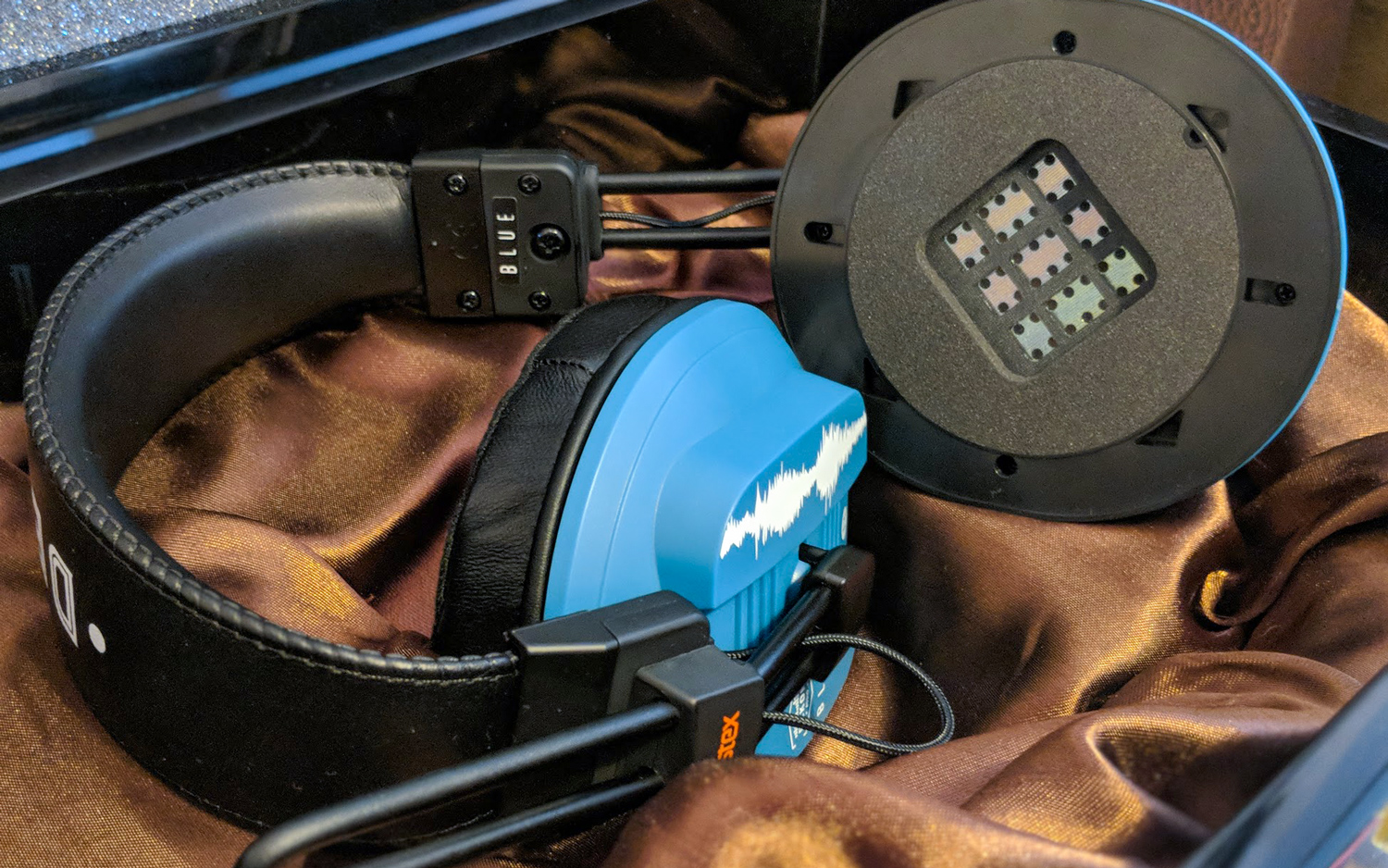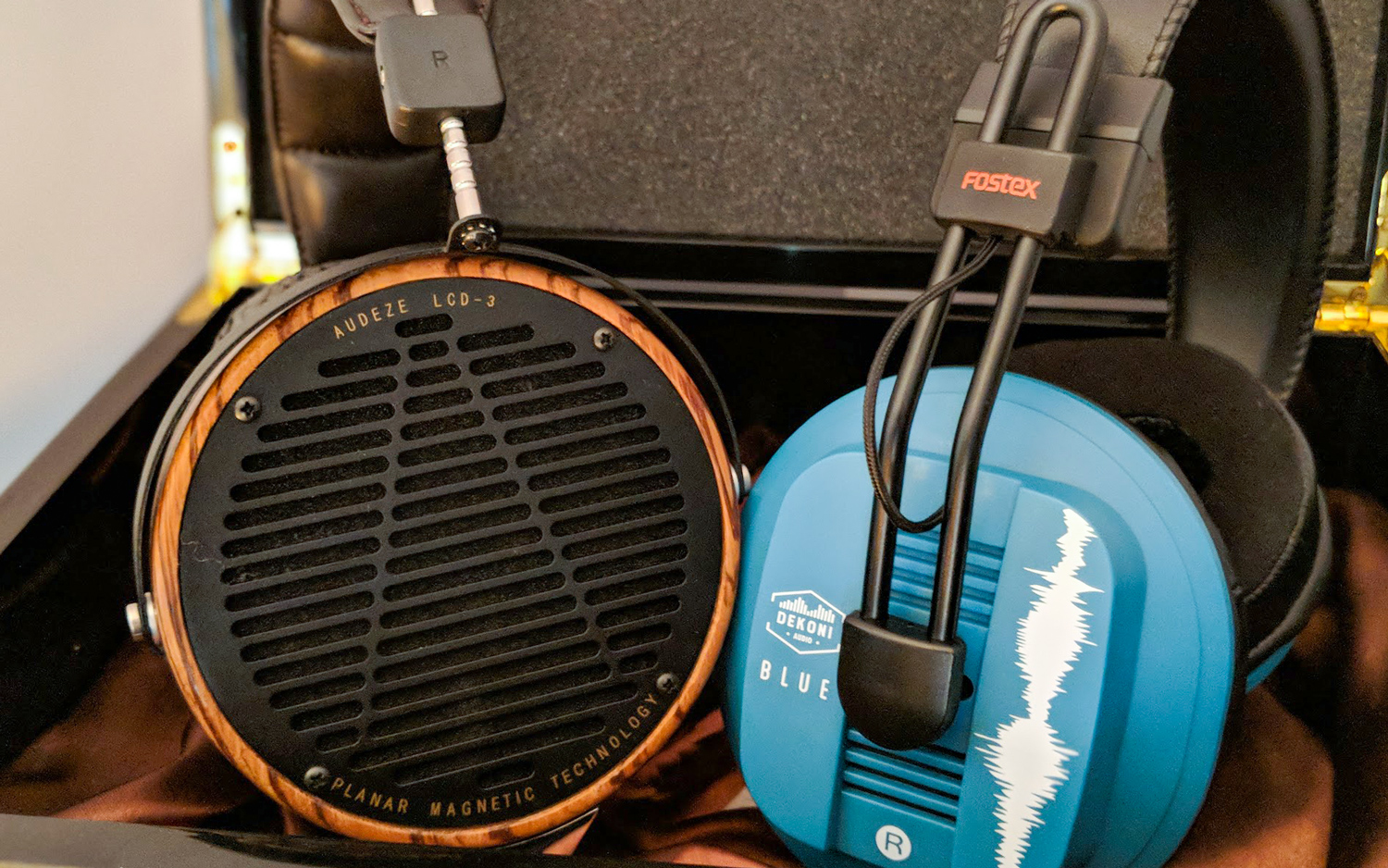Tom's Guide Verdict
The Dekoni Audio Blue Fostex offers great comfort, sound quality and modification at a bargain value.
Pros
- +
Balanced sonic profile
- +
Comfy and lightweight design
- +
Modding capabilities
- +
Inexpensive
Cons
- -
Bulky and unattractive
- -
Low sound at max volume
- -
No mobile-friendly features
Why you can trust Tom's Guide
Planar magnetic headphones are an acquired taste. They're bigger in size, sound and, of course, price. They're also the preferred headphone type among sound connoisseurs. With the all-new Dekoni Blue headphones ($299.99), Dekoni Audio presents its own planar-magnetic alternative that's not only designed for all listeners, but also relatively cheaper than the competition.
Created in collaboration with audio-engineering staple Fostex, this "custom variant" of the popular Fostex T50RP MKIII takes everything that's made the original an audiophile favorite and integrates "proprietary changes" to enhance bass response and decrease fatigue. The result is a comfy and well-balanced headphone set unmarred by its dull appearance.
Design
Unlike Audeze, or even Beats, these aren't headphones designed to make a fashion statement. Yet, what they lack in the looks department, they compensate for in longevity.
Retaining most of the T50RP's construction, the Dekoni Blue boasts a hard-plastic shell with an eye-catching, light-blue paint job that draws attention to the headset's bulky and distinctive build. The exterior is sturdy enough to withstand some normal wear and tear or the occasional drop onto the ground. Some might find the thin-layered headband a bit flimsy, but there's enough resistance to keep it from snapping in half.

The cord-lock mechanism on the left ear cup is a cool design element, especially since I occasionally remove the wires from my headphones by accident. This lock assured me that the cable would remain safely fastened during my listening sessions. A gold-plated 3.5mm adapter also comes in the box, for use on devices with headphone jacks.
Personally, I thought the Dekoni Blue would've benefited more from extra accessories and some mobile support. Headphones like the Audeze Sine, which fall under the same category, at least offer a Cipher Lightning cable with Siri-compatible microphone that works on all current iPhones.
Comfort and Fit
Despite the large real estate, these headphones are ridiculously light and slender. The Dekoni Blue weighs in at 11.3 ounces minus the cable. It's slightly comfier than the Sines.

According to Dekoni Audio, these headphones were made to be "less fatiguing," and this is apparent from the moment you wear them.The brand's hybrid ear pads have thick memory-foam padding and a velour finish on the inside that's incredibly soothing on the ears. I wore these headphones on and off throughout the day without feeling any discomfort or irritation.
The headband provides extra comfort and support to prevent any slippage. Extending the length of the headphones was seamless, with the metal sliders easily gliding through the mechanisms to adjust the fit. You won't feel exhausted or weighed down wearing these headphones for long stretches.
Magnetic Attraction
Foster is no stranger to planar magnetic technology. The company's history in the audio space traces back to decades before Audeze and Hifiman hit the scene. The Dekoni Blue takes on several of Foster's proprietary technologies, with the company's regular phase diaphragm driver spearheading the listening experience.

The original Fostex T50RP featured a copper-foil-etched polyimide film, coupled with a neodymium magnet to create "sharper audio reproduction for more-accurate monitoring." Translation: The combination of components helped to achieve a full and rich midrange without ruining acoustic output.
This same diaphragm was said to be slightly tweaked for the Dekoni Blue, to bring about lower distortion and a smoother frequency response. Those blessed with sensitive hearing will instantly pick up on these factors when testing the headphones.
MORE: Best Headphones - Top Earbuds and Headphones
Overall, the circuitry and features of the Dekoni Blue are quite remarkable when considering the affordability of these cans. They promoted great palpability, allowing me to feel the impact behind the notes and vocals of certain records. Audio sounded cleaner and more well-balanced than the T50RP across all frequencies.
Audio Performance
Most planar magnetic headphones have an open-back design, which helps to produce a more spacious soundstage while allowing ambient noise to enter. The Dekoni Blue strays from the norm and opts for a semi-open design that has sonic qualities similar to those of an open-back headphone, but with the promise of flatter, cleaner sound.

My experience with the Dekoni Blue headphones was surprising to say the least. They produced quality highs and mids, with impactful lows that boosted my energy levels the longer I listened. The low volume of these headphones creates some transparency, so you'll eventually hear some of the noise around you, though it won't disrupt your groove.
MORE: Best Noise-Cancelling Headphones
The headphones were at their best when I stuck to bass-heavy genres like hip-hop and rock. Dr. Dre's "The Chronic 2001"seemed like an ideal album to measure bass response, and I wasn't disappointed. Pressing play on a track like "Xxplosive" triggered some deep head-nodding action with the song's punchy drum pattern and iconic soul guitar riff stimulating my eardrums. Listening to the same track with more-premium headphones, like the Audeze LCD-3, revealed that the lows on the Dekoni Blue were slightly condensed, but they were still striking for a low-price headphone in this class.

Transitioning into Prince's catalog, tracks like "Computer Blue" were entrancing to hear on the Dekonisheadphones. They manifested a richer performance that projected every musical note during the extended instrumental solos. The electronic synthesizer effects and layering of guitar strings became more infectious toward the end of the record. In comparison to the LCD-3, the Dekoni Blue performed better, with livelier bass.
The Dekoni Blue plays nicely with all other music genres as well, but only in hi-res formats. I spotted a huge difference in quality when streaming Kanye West's "Runaway" on Tidal and Spotify. The piano notes sounded more distant in the chorus on Spotify, whereas Tidal's version maintained the infectious highs of the keys throughout the song.
Modded Sound
Those well-versed in modding headphones can tweak these to perform at the same level as other high-end models. The Dekoni Blue retains the same customizable capabilities as the Fostex T50RP MKIII, allowing users to personalize sound through the use of different ear pads. You're welcome to swap out the stock pads in exchange for others from the Dekoni collection or another manufacturer to suit your listening preference. Upgrading to something like Alpha Pads should warrant you improved treble and a stronger low end.
Bottom Line
We might be years away from when planar magnetic headphones become a consumer-friendly option. However, the Dekoni Audio Blue Fostex does an amazing job of making this style of headphone accessible to a bigger audience. These are entry-level cans with the comfort and sonic sharpness of high-tier headphones. The ability to customize them for fit and sound adds to their charm.
True, they aren't the most attractive planar magnetic headphones out there. Not by a long shot. Still, if you favor substance over style, there's some great audible pleasure to be had with the Dekoni Blue.
Credit: Regan Coule/Tom's Guide
A lifestyle journalist with an affinity for consumer products, Alex has over a decade of experience and has worked with popular publications such as Complex, Thrillist, Men’s Health, Gear Patrol, AskMen, and Hoop Magazine. He currently focuses on audio, reviewing the most coveted headphones in the market for both Tom’s Guide and Laptop Magazine.
-
$229 at Massdrop. No mention of the amp used to test or how notoriously hard it is to drive T50RP IIIs correctly? Barely any mention of how moddable the T50 line is or how many other variants there are like the Argon or Mayflower?Reply
-
astcd3 I can virtually guarantee that the reviewer did not hear these headphones anywhere close to their potential, based on the photo that shows it plugged directly into a laptop computer. First, these headphones highly benefit from a dedicated headphone amplifier simply to achieve satisfactory volume, as volume levels will be anemic out of nearly any source. The "Low sound at max volume" complaint would have been rectified with a dedicated headphone amp. Second, nothing less than lossless music will sound good on any decent set of headphones. For the ideal listening experience, it should be in lossless via Tidal, FLAC, or an optical disc (CD, SACD, DVD, etc). Third, these headphones will also highly benefit from an external DAC such as a Schiit Modi at a minimum, or another transport/DAC with better audio fidelity than a laptop computer.Reply
"No mobile-friendly features" is an odd complaint for these headphones. The Fostex T50rp MK3 headphones, which the Dekoni Blue are based on, were not made to be typical mass-market consumerist headphones, and so weren't made to have consumerist features. The Fostex website says that they were intended to be used as "monitor headphones by professional recording studios," so by implication, these headphones are targeted for music playback on dedicated systems, and not smartphones at all.


